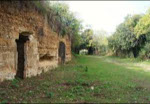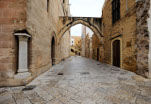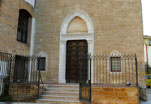Sites of naturalistic, archaeological, historical interest
The University of Palermo owns a valuable historical, artistic and naturalistic heritage, added to the museums and collections. Historical buildings of great value, chapels and paintings are regularly open to the public or can be visited on request: the Monumental complex of the Steri, the Crypt of the Repentite, the Convent of Sant'Antonino and the Oratory of the Falegnami are among them. The Fossa della Garofala is a small, still existing and unaltered, remnant of the landscape of the so-called Conca d'Oro, and has both archaeological and naturalistic interest.

Fifteen hectares of green, a strip of Conca d'Oro, the wide plain on which the city of Palermo extends, saved from the urbanization of the western part of the city, it is the legacy of an elegant garden wanted by Louis Philippe duke of Orlèans, in the 19th century. Today it houses the experimental fields of the Department of Agricultural and Forestry Sciences.

This old Franciscan convent, near the central railway station, was acquired from University of Palermo in 2004 and hosts today the University Language Centre. Built in the 18th century, it was later converted into an army barracks. Imposing restoration works has brought it back to its former glory.

The crypt came to light by chance in 2005, during some renovation works of an old religious complex in via Divisi and is currently intended for University Departments. It is still intact in its original beauty. Burial place for the “Repentite”, it preserves a valuable 17th century altar, almost intact.

This precious chapel, incorporated in the Convent of the Teatini, former headquarter of the University of Palermo in via Maqueda, is the reconstruction of the oratory destroyed during the realization of the portico, in the main building. Closed to the public and to worship for many years, it has been reopened as University Chapel in 2009.

Monumental Complex of the Steri
This complex of historical buildings of great value, occupies an area between Piazza Marina and via Scopari. It is headquarter of executive and administrative activities of the University. It is made up of Chiaramonte Palace, the Prison of the Penitenziati, the Chapel of Sant'Antonio Abate, the former Palace of Regio Lotto.

Chiaramonte Palace, known as “Steri”, is one of the iconic places of the city of Palermo. It holds seven centuries of art and history of Sicily. It is the first example of the new architectural style, that appeared in Sicily at the beginning of the 14th century, the style precisely called “chiaramontano”. The palace, after several uses, is now the seat of the Rectorate.

This 16th century building for a long time housed the Inquisition prisons and then the Royal Court. It collects several graffiti, living proof of the dark and terrible time of Inquisition, thanks to the meticulous work of the Palermitan ethnologist Giuseppe Pitrè, that brought them to light at the beginning of the 20th century.

This small and elegant chapel, dedicated to S. Antonio Abate whose devotes were the crusaders coming back from Holy Places, was commissioned by Manfredi I. It is in fact the private chapel of the Chiaramonte family. Among its peculiarities, high on a wall, there is the discovery of a Christ face portray similar to that one painted on a roof beam of the Sala Magna of the Steri.
Centro Servizi Sistema Museale di Ateneo
Università degli Studi di Palermo
Via Lincoln, 2 (Orto Botanico)
90133 PALERMO, Italia
Codice Fiscale 80023730825, Partita IVA 00605880822
091 238 96775 - 091 238 93781
